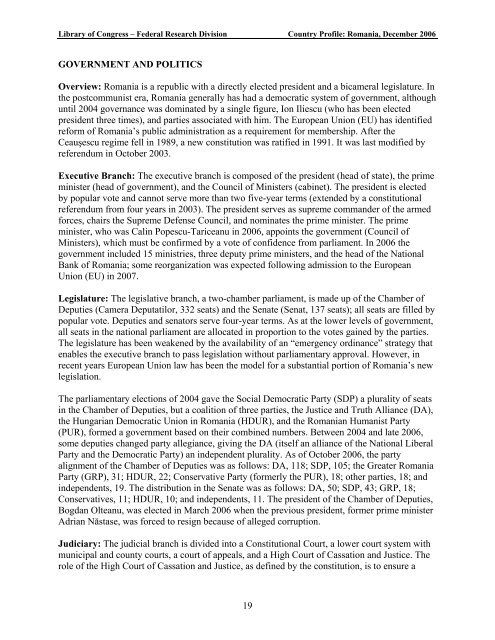Country Profile: Romania - Library of Congress
Country Profile: Romania - Library of Congress
Country Profile: Romania - Library of Congress
You also want an ePaper? Increase the reach of your titles
YUMPU automatically turns print PDFs into web optimized ePapers that Google loves.
<strong>Library</strong> <strong>of</strong> <strong>Congress</strong> – Federal Research Division <strong>Country</strong> <strong>Pr<strong>of</strong>ile</strong>: <strong>Romania</strong>, December 2006<br />
GOVERNMENT AND POLITICS<br />
Overview: <strong>Romania</strong> is a republic with a directly elected president and a bicameral legislature. In<br />
the postcommunist era, <strong>Romania</strong> generally has had a democratic system <strong>of</strong> government, although<br />
until 2004 governance was dominated by a single figure, Ion Iliescu (who has been elected<br />
president three times), and parties associated with him. The European Union (EU) has identified<br />
reform <strong>of</strong> <strong>Romania</strong>’s public administration as a requirement for membership. After the<br />
Ceauşescu regime fell in 1989, a new constitution was ratified in 1991. It was last modified by<br />
referendum in October 2003.<br />
Executive Branch: The executive branch is composed <strong>of</strong> the president (head <strong>of</strong> state), the prime<br />
minister (head <strong>of</strong> government), and the Council <strong>of</strong> Ministers (cabinet). The president is elected<br />
by popular vote and cannot serve more than two five-year terms (extended by a constitutional<br />
referendum from four years in 2003). The president serves as supreme commander <strong>of</strong> the armed<br />
forces, chairs the Supreme Defense Council, and nominates the prime minister. The prime<br />
minister, who was Calin Popescu-Tariceanu in 2006, appoints the government (Council <strong>of</strong><br />
Ministers), which must be confirmed by a vote <strong>of</strong> confidence from parliament. In 2006 the<br />
government included 15 ministries, three deputy prime ministers, and the head <strong>of</strong> the National<br />
Bank <strong>of</strong> <strong>Romania</strong>; some reorganization was expected following admission to the European<br />
Union (EU) in 2007.<br />
Legislature: The legislative branch, a two-chamber parliament, is made up <strong>of</strong> the Chamber <strong>of</strong><br />
Deputies (Camera Deputatilor, 332 seats) and the Senate (Senat, 137 seats); all seats are filled by<br />
popular vote. Deputies and senators serve four-year terms. As at the lower levels <strong>of</strong> government,<br />
all seats in the national parliament are allocated in proportion to the votes gained by the parties.<br />
The legislature has been weakened by the availability <strong>of</strong> an “emergency ordinance” strategy that<br />
enables the executive branch to pass legislation without parliamentary approval. However, in<br />
recent years European Union law has been the model for a substantial portion <strong>of</strong> <strong>Romania</strong>’s new<br />
legislation.<br />
The parliamentary elections <strong>of</strong> 2004 gave the Social Democratic Party (SDP) a plurality <strong>of</strong> seats<br />
in the Chamber <strong>of</strong> Deputies, but a coalition <strong>of</strong> three parties, the Justice and Truth Alliance (DA),<br />
the Hungarian Democratic Union in <strong>Romania</strong> (HDUR), and the <strong>Romania</strong>n Humanist Party<br />
(PUR), formed a government based on their combined numbers. Between 2004 and late 2006,<br />
some deputies changed party allegiance, giving the DA (itself an alliance <strong>of</strong> the National Liberal<br />
Party and the Democratic Party) an independent plurality. As <strong>of</strong> October 2006, the party<br />
alignment <strong>of</strong> the Chamber <strong>of</strong> Deputies was as follows: DA, 118; SDP, 105; the Greater <strong>Romania</strong><br />
Party (GRP), 31; HDUR, 22; Conservative Party (formerly the PUR), 18; other parties, 18; and<br />
independents, 19. The distribution in the Senate was as follows: DA, 50; SDP, 43; GRP, 18;<br />
Conservatives, 11; HDUR, 10; and independents, 11. The president <strong>of</strong> the Chamber <strong>of</strong> Deputies,<br />
Bogdan Olteanu, was elected in March 2006 when the previous president, former prime minister<br />
Adrian Năstase, was forced to resign because <strong>of</strong> alleged corruption.<br />
Judiciary: The judicial branch is divided into a Constitutional Court, a lower court system with<br />
municipal and county courts, a court <strong>of</strong> appeals, and a High Court <strong>of</strong> Cassation and Justice. The<br />
role <strong>of</strong> the High Court <strong>of</strong> Cassation and Justice, as defined by the constitution, is to ensure a<br />
19

















